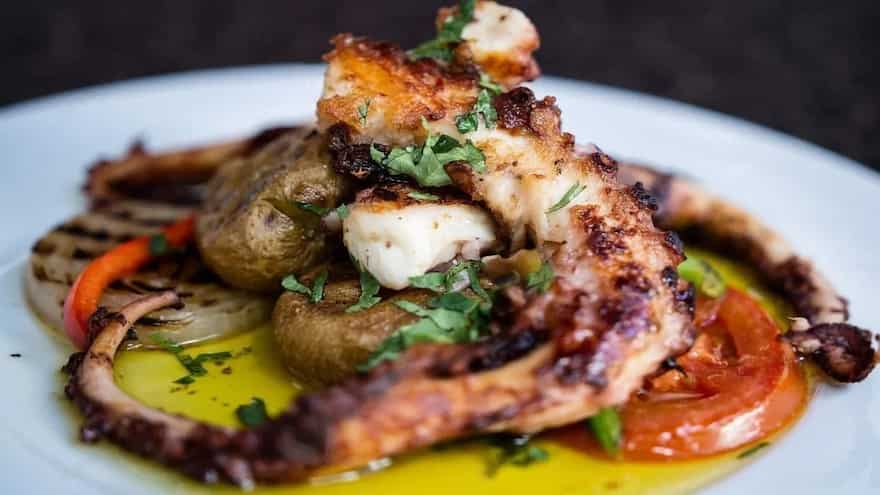The FIFA World Cup has shifted the focus on Portugal for many of us. However, the country is not just about football. It gives some solid food goals. The Age of Discovery had a significant impact on Portuguese cuisine. As a result, seafood reigns supreme in Portuguese cookery, while pork holds its own inland. The Alentejo's substantial regional cooking, for example, is built on slow-cooked porco preto, lamb, and bread, all of which are prepared in various ways. Portuguese cuisine is supported by multiple classic recipes with Mediterranean origins but studded with African, Brazilian, and Spice Route pzazz. Today, Europe's new culinary darling has transformed this worldwide mash-up into one of the continent's most rigorous and vibrant cuisines. Let's explore a few of them.
Bacalhau

Bacalhau à Brás, Image Source: Shutterstock
You needn't hunt for bacalhau (salted cod) in Portugal; it will reach you. Bacalhau, a pre-refrigeration technique of preserving fish in salt, is still practised in Portugal. Every year, around 25,000 tonnes of bacalhau are imported. Some believe there are at least 1000 methods. Bacalhau can be roasted as a fillet or in casseroles, grilled, or shredded with scrambled eggs, onions, and fried potatoes. The fact is you can't leave the country without eating it. Try bacalhau à Gomes de Sá,bacalhau à Brás, bacalhau com natas and bacalhau à Lagareiro.
Arroz de marisco
 Portuguese seafood rice, Image Source: Dreamtime
Portuguese seafood rice, Image Source: Dreamtime
It is a Portuguese seafood rice dish. You may draw parallels by considering it as a soupier form of risotto laden with various ocean goodies, including tamboril (monkfish), bacalhau, and a variety of crustaceans harvested fresh from the Atlantic. The lobster or sea fish is weighed and then whipped into seafood rice or massadas (pasta instead of rice) on the spot, depending on your preferences. Serve with fresh santola or sapateira crabs from the shell as an appetiser.
Arroz de pato
Duck rice is a delicious combination of cooked and shredded duck snuggled in a bed of Carolino rice. It is then roasted briefly before being topped with spicy chouriço sausage and served with orange slices. It originated in Alentejo, like many of Portugal's heartier meals, but spread fast throughout the country. Many recommend trying it at Teresa Ruo's 17th-century farmhouse, the chef behind the award-winning Cozinha da Terra.
Sardinhas assadas

Grilled sardines, Image Source: Shutterstock
In Portugal, during the festive summer season, the enticing aroma of frying sardines fills the air among rustic neighbourhoods. June to October is the season, and this is when they are at their plumpest and tastiest. Freshly grilled sardines are widely available. Sardines that have been coarsely salted and grilled over hot coals, then eaten with broa (corn bread) or, in restaurants, served alongside customary sides of bell pepper salad and boiled potatoes.
Polvo à Lagareiro
 Portuguese famous octopus dish, Image Source: Dreamtime
Portuguese famous octopus dish, Image Source: Dreamtime
One of the most popular dishes in the country, polvo à Lagareiro, is thought to have originated in the Beiras region of central Portugal. A juicy octopus, tentacles and all, is roasted and tossed in essential Mediterranean spices before being served with slow-baked potatoes. One of the best in Portugal is at Páteo (Bairro do Avillez). It is among the most casual kitchens of Michelin-starred chef José Avillez's culinary empire. Persuaded by the success of his fine-dining jewel Belcanto, the country's most famous chef, practically single-handedly kick-started Portugal's gourmet resurgence. Thus, it would be negligent not to try his take on this wonderful hometown favourite in which he adds rapini and onion sauce.
Pastel de nata
 Pastel de nata, Image Source: needpix.com
Pastel de nata, Image Source: needpix.com
It is known generically as pastel de nata around the world. It is protected as pastel de Belém at Antiga Confeitaria de Belém, which is supposed to have originated in the Lisbon suburbs in 1837. The secret of this iconic dessert lies in the textural yin-and-yang between the creamy egg custard filling and the flaky pastry crust. It is passed down by monks at the nearby UNESCO-listed Jerónimos Monastery. Powdered sugar and/or cinnamon are sprinkled on top to taste.


